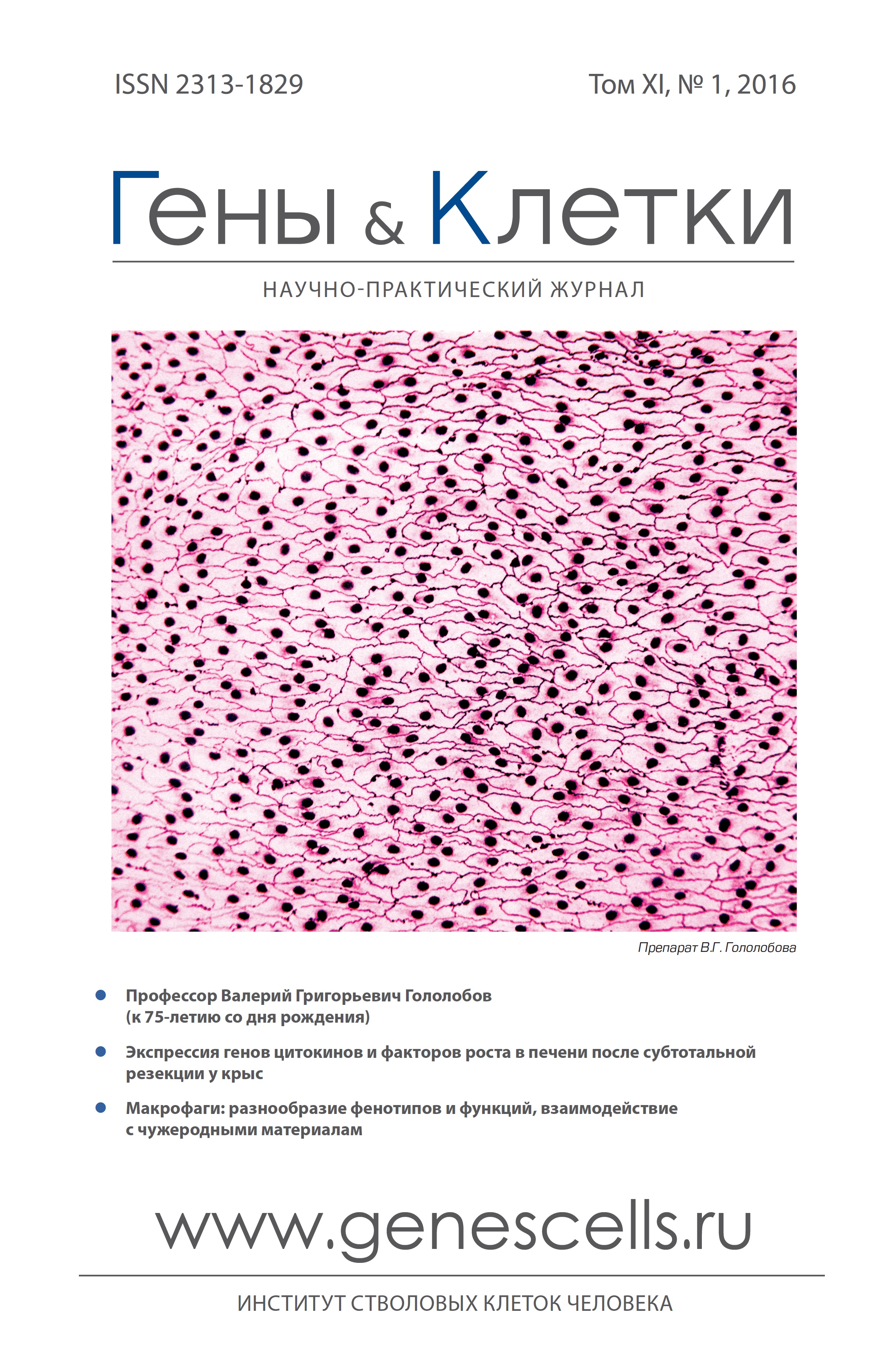Prospects for tissue engineered bile duct
- Authors: Dyuzheva T.G1, Lyundup A.V1, Klabukov I.D1, Chvalun S.N2, Grigorev T.E2, Shepelev A.D2, Tenchurin T.H2, Krasheninnikov M.E1, Oganesyan R.V1
-
Affiliations:
- Sechenov First Moscow State Medical University
- National Research Center “Kurchatov Institute"
- Issue: Vol 11, No 1 (2016)
- Pages: 43-47
- Section: Articles
- URL: https://genescells.ru/2313-1829/article/view/120563
- DOI: https://doi.org/10.23868/gc120563
- ID: 120563
Cite item
Abstract
Full Text
About the authors
T. G Dyuzheva
Sechenov First Moscow State Medical University
A. V Lyundup
Sechenov First Moscow State Medical University
I. D Klabukov
Sechenov First Moscow State Medical University
Email: ilya.klabukov@gmail.com
S. N Chvalun
National Research Center “Kurchatov Institute"
T. E Grigorev
National Research Center “Kurchatov Institute"
A. D Shepelev
National Research Center “Kurchatov Institute"
T. H Tenchurin
National Research Center “Kurchatov Institute"
M. E Krasheninnikov
Sechenov First Moscow State Medical University
R. V Oganesyan
Sechenov First Moscow State Medical University
References
- Гальперин Э.И., Дюжева Т.Г., Чевокин А.Ю. Стриктуры желчных протоков. В: Гальперин Э.И., Ветшева П.С., редакторы. Руководство по хирургии желчных протоков. М.: Видар; 2006. с. 503-22.
- Kimura Y., Takada T., Kawarada Y. et al. Definitions, pathophysiology, and epidemiology of acute cholangitis and cholecystitis: Tokyo Guidelines. J. Hepat. -Bil. -Pancr. Surg 2007; 14(1): 15-26.
- Soehendra N., Reynders-Frederix V. Palliative bile duct drainage-a new endoscopic method of introducing a transpapillary drain. Endoscopy 1980; 12(1): 8-11.
- Laurence B.H., Cotton P.B. Decompression of malignant biliary obstruction by duodenoscopic intubation of bile duct BMJ 1980; 280(6213): 522-23.
- Blero D., Huberty V., Devière J. Novel biliary self-expanding metal stents: indications and applications. Exp. Rev. Gastroenterol. Hepatol. 2015; 9(3): 359-67.
- Rey J.F. Dumas R., Canard J.M. et al. Guidelines of the French Society of Digestive Endoscopy: biliary stenting. Endoscopy 2002; 34(2): 169-73.
- Jang S.I., Lee D.K. Stents with specialized functions: drug-eluting stents and stents with antireflux devices. Gastrointest. Interv. 2015; 4(1): 50-4.
- Aikawa M., Miyazawa M., Okamoto K. et al. A novel treatment for bile duct injury with a tissue-engineered bioabsorbable polymer patch. Surgery 2010; 147(4): 575-80.
- Rosen M., Ponsky J., Petras R. Small intestinal submucosa as a bioscaffold for biliary tract regeneration. Surgery 2002; 132: 480-6.
- Ellis H., Hoile R.W. Vein patch repair of the common bile duct J. Royal Soc. Med. 1980; 73(9): 635.
- Sedgwick C.E. Reconstruction of the common bile duct with a free ureteral graft; an experimental study. Surg. Gynecol. Obstet. 1951; 92: 571-3.
- Aydin M., Bakir B., Kösem M. et al. Biliary tract reconstruction with autologous rectus sheath graft--an experimental study Hep -Gastroenterol. 2004; 52(64): 1019-22.
- Дюжева Т.Г., Савицкая Е.Е., Котовский А.Е. и соавт. Биодеградируемые материалы и методы тканевой инженерии в хирургии желчных протоков. Анналы хирургической гепатологии 2012; 17(1): 94-9.
- Haber G.B., Freeman M.L., Bedford R. et al. A prospective multi-center study of a bioabsorbable biliary wallstent (BAS) in 50 patients with malignant obstructive jaundice (MOJ) Gastrointest Endosc. 2001; 53(5): AB121.
- Yamamoto K., Yoshioka T., Furuichi K. et al. Experimental study of poly-L-lactic acid biodegradable stents in normal canine bile ducts Cardiovasc. Intervent. Radiol. 2011; 34: 601-8.
- Tao L., Li Q., Ren H. et al. Repair of extrahepatic bile duct defect using a collagen patch in a swine model. Artificial organs 2015; 39(4): 352-60.
- Alonso A.J., del Olmo Rivas C., Machado Romero I. et al. Bile duct reconstruction using 3-dimensional collagen tubes. Cirugia Espanola (English Edition) 2013; 91(9): 590-4.
- Ismail A., Ramsis R., Sherif A. et al. Use of human amniotic stem cells for common bile duct reconstruction: vascularized support of a free amnion graft. Med. Sci. Monitor Bas. Res. 2009; 15(9): BR243-7
- Mills S.E., editor Histology for pathologists 4th Ed Philadelphia: Lippincott Williams & Wilkins; 2012.
- Sutton M.E., Dries S., Koster, M.H. et al. Regeneration of human extrahepatic biliary epithelium: the peribiliary glands as progenitor cell compartment. Liver International 2012; 32(4): 554-9
- Онищенко Н.А., Люндуп А.В., Газизов И.М. и др. Двухфазная динамика воздействия мезенхимальных мультипотентных стромальных клеток (ММСК) костного мозга на печень при моделировании фиброзирующего гепатита Вестник трансплантологии и искусственных органов 2011; 13(3): 51-8.
- Barralet J.E., Wallace L.L., Strain A.J. Tissue engineering of human biliary epithelial cells on polyglycolic acid/polycaprolactone scaffolds maintains long-term phenotypic stability Tissue engineering 2003; 9(5): 1037-45.
- Miyazawa M., Torii T., Toshimitsu Y. et al. A tissue-engineered artificial bile duct grown to resemble the native bile duct Am J Transpl. 2005; 5(6): 1541-7.
- Zong С., Wang M., Yang F. et al. A novel therapy strategy for bile duct repair using tissue engineering technique: PCL/PLGA bilayered scaffold with hMSCs Journal of tissue engineering and regenerative medicine. 2015; 4(7): 524-31.
- Yang J., Cao С., Wang W. et al. Proliferation and osteogenesis of immortalized bone marrow-derived mesenchymal stem cells in porous polylactic glycolic acid scaffolds under perfusion culture J Biomed. Mat. Res. Part A 2010; 92(3): 817-29.
Supplementary files










